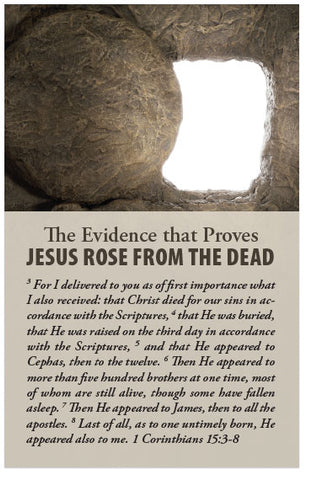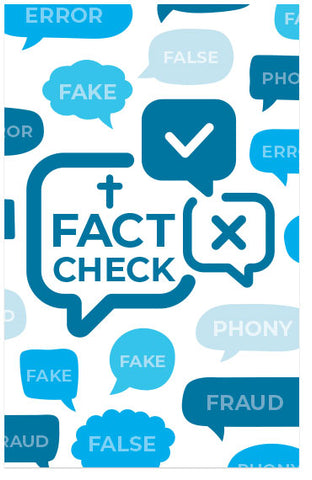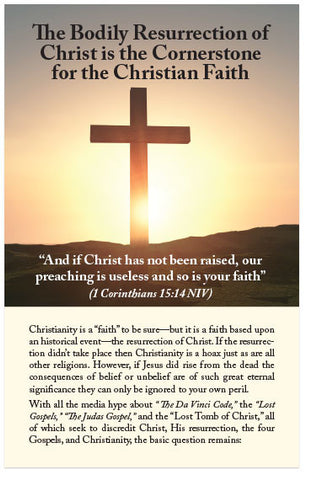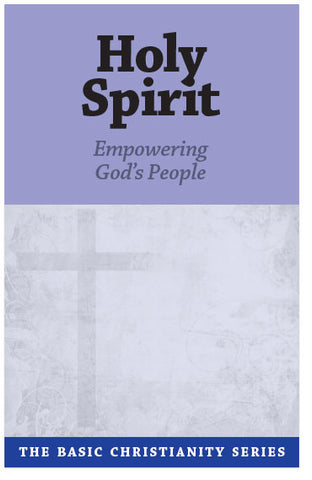Historical Evidence for the Death and Resurrection of Jesus Christ
Special-Order Folded Tract
 NOTE: This item is custom-printed to order (click for more details).
NOTE: This item is custom-printed to order (click for more details).
This tract is from our print-on-demand library, and is not kept in stock. Select the options below, and we will custom-print a batch just for you. Because this item is custom-printed, you can add your custom imprint to the back page at no extra cost.
- Estimated shipping date: Wednesday, December 31 (Click for more details)
- SKU:
- Discounts: Discount coupons do not apply to this item
- Format: Folded Tract
- Size: 3.5 inches x 5.5 inches
- Pages: 4
- Imprinting: Available with 5 lines of custom text
- Returns: Because this item is custom-printed to order, it cannot be returned.
Show all item details
The full text of this tract is shown below. (Do you want to print this tract in a different version than the one listed? Contact us and let us know what you're looking for—we may be able to create the alternate version for you at no charge.)
The Bible makes it clear that Christ died on a cross (Matt 27:32-61; Mark 15:33-47; Luke 23:44-56; John 19:28-42) and three days later Jesus came back to life and left the tomb in which He was buried (Matt 28:1-7; Mark 16:1-8; Luke 24:1-12; John 20:1-10; Acts 1:4-8; 9:1-9; 1 Cor 15:6-8).
I love the Bible and trust it as a reliable and credible witness to events that occurred in the first century. Yet, the Bible is not the only witness to the death and resurrection of Jesus Christ. There are five different categories of sources that contain at least thirteen different independent references to the death and resurrection of Jesus Christ.
Ancient Historians
The first category comes from ancient historians. Tacitus (first century AD) wrote about a Christian that suffered under Pontius Pilate (the man who sentenced Christ to death). Josephus (AD 37-97) says that Jesus died and appeared “alive” again to his disciples. Thallus (AD 52) describes the physical events of Jesus’s death just as they were recorded in Luke 23:44-45. Scholars say Thallus wrote in AD 52 while Luke did not write his Gospel until AD 65.
Jewish Sources
A second category is Jewish sources. The Talmud (AD 70-200) directly references the crucifixion of Jesus Christ. The Toledoth Jesu (fifth century) states that Jesus was in a tomb but was resurrected and not at the tomb when people came to see him days after his death.
Gentile Sources
A third category is Gentile sources. Lucian says that Jesus was the founder of Christianity and was “crucified” for it. Mara Bar-Seraphone was a Syrian (late first century) who wrote a letter to his son describing how the Jews “executed” Jesus.
Gnostic Sources
A fourth category is “gnostic” sources which talk about Jesus directly but are much less credible than books that are in the Bible. The Gospel of Truth (second century) referenced Jesus as a historical person who had a “death for many … nailed to a tree.” The Treatise on the Resurrection (late second century) says that Jesus died and came back to life. The Gospel of Thomas (second century) records Jesus’s death. The Gospel of Peter describes how Mary and other women went to the tomb of Jesus but he was not there.
Lost Sources
The fifth category is “lost” sources which we do not have copies of, but portions of these writings are quoted in writings that we do have. The Acts of Pontius Pilate says that in Jesus’s crucifixion he was pierced in his hands and feet. Phlegon (born in AD 80) wrote that Jesus was alive, died, and arose to life after his death.
By no means is this an exhaustive list (just a simple one compiled by a church pastor). There are other “evidences” that Jesus lived, died, and came back to life. My prayer for you is that you accept him as your Savior that died for you. Because it is through faith in Him that you are saved and will spend eternity in heaven with Him.
By: Christopher L. Scott











